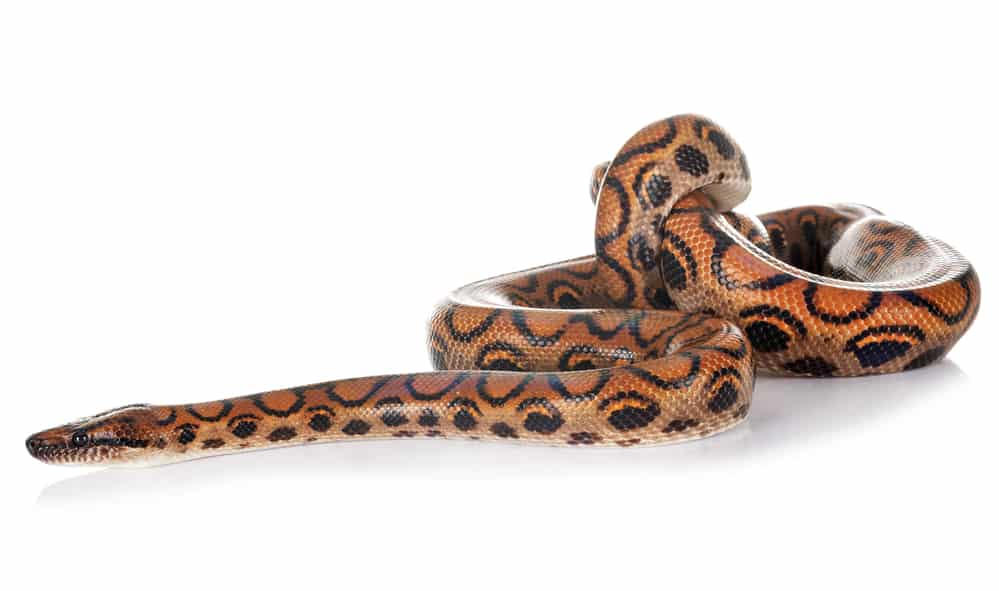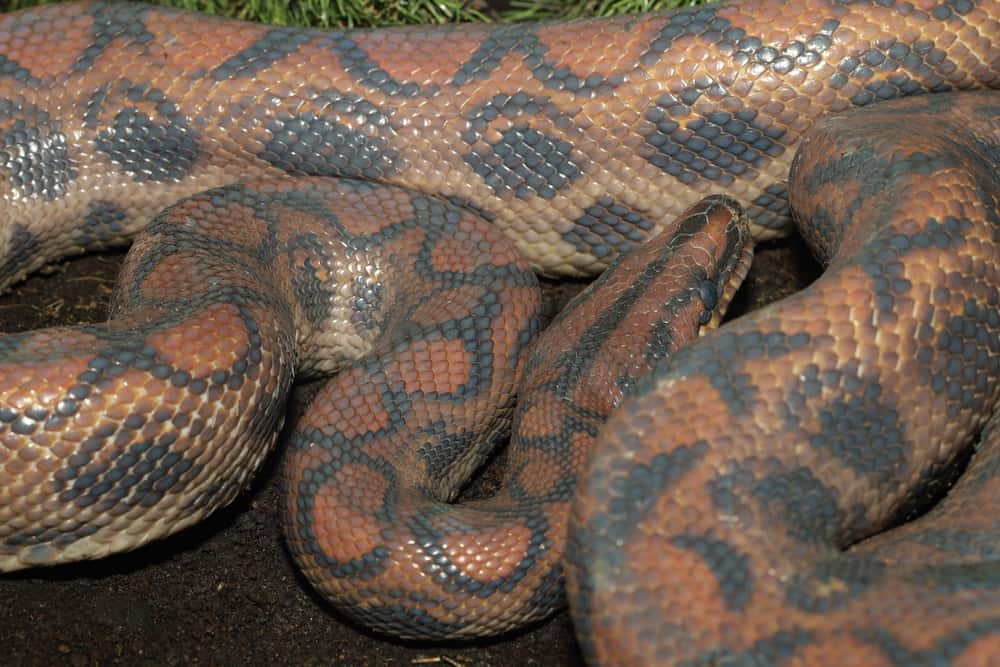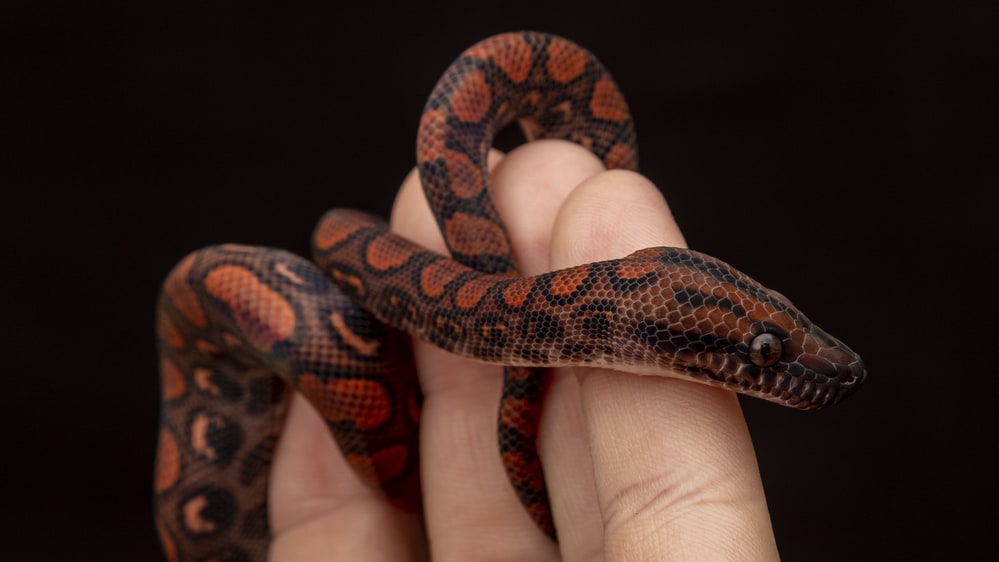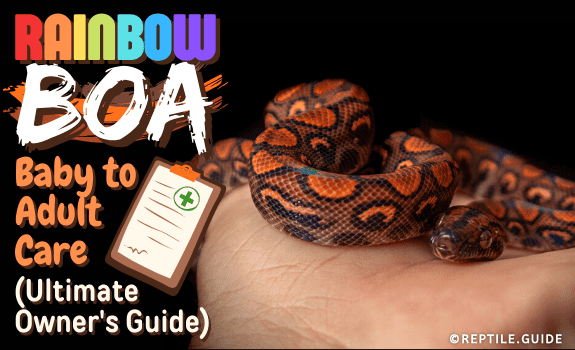The rainbow boa, Epicrates. sp., has striking coloration, grows to a manageable size, and is relatively easy to keep.
This care sheet covers all the basic information you need to successfully keep and breed this beautiful snake.
In This Article
Background Information
Rainbow boas belong to the genus Epicrates. The Brazilian Rainbow boa, Epicrates cenchria, is the most commonly kept rainbow boa species.
When properly cared for, this species can live between 20-25 years in captivity.
Besides the Brazilian Rainbow boa, there are four other species of Rainbow boa:
- Caatinga Rainbow Boa, Epicrates assisi
- Argentine Rainbow Boa, Epicrates alvarezi
- Colombian Rainbow Boa, Epicrates maurus
- Paraguayan Rainbow Boa, Epicrates crassus
Scientists originally classified Brazilian rainbow boas as nine subspecies. In 2008 they reduced the list to five subspecies, namely:
- Brazilian Rainbow Boa, Epicrates c. cenchria
- Peruvian Rainbow Boa, Epicrates c. gaigei
- Marajo Island Rainbow Boa, Epicrates c. barbouri
- Esprito Santo Rainbow Boa, Epicrates c. hygrophilus
- Central Highland Rainbow Boa, Epicrates c. polylepis
If you buy a rainbow boa, it will most likely be the Brazilian rainbow boa. Still, it pays to confirm what species you’re getting.
It’s important to know which species you’re getting as some species are threatened in the wild.
The Colombian Rainbow is the second most commonly sold rainbow boa. It’s commonly mistaken for the Brazilian Rainbow due to its similar coloration.
The Brazilian Rainbow is more iridescent than the Colombian, and it has greater color variation.
Colombian Rainbow boas are smaller than Brazilians, and morphs for this species are readily available.
Brazilian Rainbow Boa Size
The Brazilian Rainbow is the largest of the rainbow boas, with adults reaching up to six feet in length. Some individuals may only reach lengths of around four feet.
By comparison, the Colombian rainbow boa only reaches lengths of between three and five feet.
If you’re unsure of the species, rest assured that you can expect a rainbow boa to reach lengths of no more than six feet.
Rainbow Boa Appearance
Rainbow boas get their name from their iridescent colors. The scales of this species have ridges, which act as prisms. Light reflected off the scales creates a rainbow-like effect.
Brazilian rainbow boas are reddish or brownish, with dark rings that run along the length of the body. They also have three parallel stripes on top of their heads.

Most species of rainbow boa have similar coloration, though the Esprito Santo has white and black hatchlings.
Though the iridescent colors of these species are striking, they serve as effective camouflage. In the wild, their colors blend in with the natural foliage.
Distribution and Habitat
Rainbow boas come from the South America basin countries, which include:
- Brazil
- French Guiana
- Guyana
- Southern Venezuela
- Suriname
Rainbow boas inhabit rainforests, humid woodlands, and open savannahs. Though they’re primarily terrestrial, they have prehensile tails and sometimes climb trees.
Rainbow Boa Behavior
As with most boa species, the rainbow boa is nocturnal and solitary. They rest in the daytime and feed at night.
Rainbow boas are ambush predators; they lie in wait for their prey to get close enough for them to strike.
They use their tongues and labial pits to detect prey, even on the darkest nights.
The tongues of these snakes detect the chemical composition of prey, while their labial pits can detect the body heat of mammals and birds.
Their strong sense of smell and the heat detection of the labial pits allow the boas to “see” prey by letting them construct an image of potential prey animals nearby.
Young rainbow boas take refuge in trees to avoid predators. As they get older, they become terrestrial.
Rainbow Boa Care
Caring for a rainbow boa is easy if you have some prior experience with snake care. Below, we’ll share everything you need to know to care for your rainbow boa.
Enclosure Setup
For rainbow boas, plastic or glass terrariums make more suitable enclosures than wood, given the high humidity requirements of this species.
Damp wood can lead to the growth of fungi and bacteria.
The recommended enclosure size for adult rainbow boas is 48 inches long, 24 inches deep, and 24 inches wide. You can keep hatchlings in a 10-gallon aquarium.
Temperature and Lighting
Though rainbow boas are tropical animals, they require lower temperatures than many other reptiles.
As with other reptiles, rainbow boas are cold-blooded.
Your boa is unable to regulate its temperature on its own. To cool down or warm-up, it needs to find a spot that has its desired temperature.
To allow them to do this, you should establish a temperature gradient in the enclosure where one part remains cooler than the other.
Never allow the temperature to go over 90 degrees, as this can prove fatal.
The ideal temperatures are as follows:
-
Warm side: 80-85 °F
-
Cool side: 75-80 °F
-
Ambient daytime temperature: 80-85 °F
-
Ambient nighttime temperature: 70-75 °F
You can heat the enclosure using a basking light or an under-tank heating pad. By putting the basking light or heating pad on one end of the cage, the other end will be cooler.
The advantage of an under-tank heating pad is that it maintains the desired temperature 24/7.
If you’re only using a basking light to heat the enclosure, you need another heat source in the evening when the lights are off.
We don’t recommend hot rocks as reptiles can burn themselves. Heating pads are the ideal choice.
It’s best to buy a digital thermostat for reptile enclosures to control the heating pad and maintain the enclosure’s temperature.
Incorporate three thermometers into the tank, one one each side and one in the center. This setup will allow you to monitor both heat extremes and the ambient temperature.
It’s important to give your rainbow boa a day and night light cycle. Light the enclosure during the day (12 hours) but not at night (another 12 hours).
As rainbow boas are nocturnal, they don’t need UV lighting for health reasons. UV lighting may be needed to maintain the light cycle.
Also, UV lighting will bring out its amazing colors. It would be necessary if you have any live plants in the enclosure.
We recommend using full-spectrum LED lighting to provide a realistic day and night cycle and make your snakes shine.
Furnishings
Rainbow boas are shy and secretive animals, so it’s important to give them multiple hides.
Provide a hide on the warm side of the tank (near the basking area) and one on the cool side (on the opposite side of the tank).
By doing this, your snake can feel secure no matter where it is in the enclosure. It’s also advisable to provide a humid hide, which is a hide that holds humidity.
Humid hides are plastic boxes which are large enough to contain your snake, with an entrance for the boa.
By furnishing the hide with damp moss or another substrate that stays moist, the humid box maintains higher humidity than the rest of the enclosure.
It gives your snake access to more humidity if it needs it, and can help facilitate shedding.

You should also equip the tank with a large water bowl. Boas enjoy soaking in water, and a large water bowl will help keep the humidity levels high enough.
You should change the water in the bowl daily, and clean it weekly.
Humidity
Besides overheating, the most common cause of death for rainbow boas is dehydration. Rainbow boas require humidity levels of between 75-90%.
One of the best ways is to equip the enclosure with an automated mister or humidifier.You can also mist the enclosure daily using a spray bottle filled with water.
Pro Tip: If your snake’s skin comes off in patches when shedding, rather than in one piece, it’s a sign that the humidity level is too low.
Whether you’re using an automated system or doing it manually, you want to keep the humidity up without causing water to collect on the substrate.
Too much misting can lead to bacteria and fungus growth in the enclosure, leading to diseases like mouth rot.
If you decide to use a misting system, be sure to choose one with variable output, so you can prevent overmisting.
The following mosses can also help in increasing the humidity:
- Pillow moss
- Sheet moss
- Royal pillow moss
- Sphagnum peat moss
- Green sphagnum peat moss
- Golden sphagnum peat moss
Substrate
When choosing a substrate for the enclosure, it’s important to consider how it will hold up to humidity.
The ideal substrate will maintain moisture, but be resistant to mold and bacteria.
A substrate that holds moisture will help maintain the humidity level.
Recommended substrate include:
- Newspaper
- Orchid bark
- Coconut husk
- Cypress mulch
- Sphagnum peat moss
Spot clean the substrate daily to remove fecal matter.
Clean and disinfect the whole enclosure monthly, and replace the substrate completely.
Rainbow Boa Feeding
In the wild, rainbow boa feed mainly on small mammals, birds, and small reptiles.
Rainbow boas are excellent swimmers but don’t normally pursue prey in the water. They sometimes hunt amphibians at the water’s edge.
There are some reports of rainbow boas feeding on bats.
They either enter caves and pursue their prey or lie in wait at the cave entrance. Research also shows that bats compose a small part of this snake’s diet.
In captivity, baby and juvenile rainbows eat pinkies or small mice. Adult rainbow boas can eat adult mice or rats.
Babies and juveniles need to eat once or twice a week. You can feed adults once every seven to ten days.
Pro Tip: You can judge the right feeder size by selecting feeders that are no larger than the thickest part of your snake’s body.
When feeding your snakes, DON’T give them live rodents. Buy frozen feeders as it’s safer for your snake. Live feeders can injure your snake or have parasites.
These boas are nocturnal ambush predators, so it’s best to feed them at night.
Some keepers feed their rainbows in a separate container instead of in their enclosure. When you feed snakes in their cage, they associate you with food.
Because of their feeding response, snakes may bite you when you open the cage. Feeding your snake in another container will prevent them from developing this association.
An alternative would be maintaining your rainbow’s enclosure and handling the snake regularly.
This kind of socialization can also help prevent your snake from being triggered when you open its enclosure.
Don’t handle your snake for 24 hours after it eats, as this can cause it to regurgitate its food.
Rainbow boas sometimes stop eating their favorite foods. Should this occur, try feeding them a different kind of feeder.
If your snake’s favorite food was mice, try giving it a rat. You can also try giving it a chick or hamster. As mentioned before, don’t offer live feeders.
It’s not unusual for rainbow boas to stop eating in the winter months.
If your snake was a good eater but stopped accepting food during this time of the year, there’s no need for alarm.
Handling
Rainbow boas are shy, and they can be nippy. This is especially true when they’re young.
Most rainbow boas become tame with regular handling and with age. Until your snake tames down, we recommend using a snake hook to move your snake around.
Rainbow boas are nocturnal, so avoid handling them at night. This approach will reduce your chances of getting bitten.
The proper way to handle your boa is to gently slide your hand under the snake’s body. Avoid picking it up near its head. Instead, pick it up further down its body.
When you lift up the snake, fully support its body. Avoid grabbing your snake. Instead, let it move around freely, and adjust your hands to manage its movements.
It’s important to get your snake accustomed to handling by taking incremental steps. When you first handle your snake, do so for only a short period of time.
You can gauge the time by how the snake responds to you. Try handling your snake twice a week.
Each time you handle your snake, handle it for a longer period of time so that you can gain its trust.
As stated before, don’t handle your snake 24 hours after it has eaten.
Health Issues
You can prevent most rainbow boa health issues by meeting their needs as provided in this care sheet.
Daily spot cleaning of the substrate and monthly deep cleanings are important for preventing the spread of bacteria.
When deep cleaning, sanitize the entire enclosure and replace the substrate with a new substrate.
When using sanitizer, select one approved for reptiles as some may be toxic to reptiles. It’s essential to follow the manufacturer’s instructions.
The following are potential health issues that you may encounter:
Anorexia
In reptiles, anorexia refers to a lack of appetite or feeding response. It’s not a disease, but usually it’s a symptom of improper care.
If your snake isn’t eating, it’s important to evaluate the animal’s care. Common causes include:
- Improper diet
- Photoperiods
- Improper lighting
- Improper humidity
- Excessive handling
- Improper temperature
If your snake presents with anorexia, have your snake inspected by a veterinarian who’s experienced in treating reptiles.
Obesity
It’s important not to overfeed your snake as it may lead to obesity, which can lead to other health issues.
By following the guidelines provided in this care sheet, you won’t experience this problem.
Dry Eyes
When shedding, snakes shed their entire skin in one piece, including their eye caps. Dry eyes are a condition where the snake eye caps remain attached to their eyes.
The attached eye caps cause irritation for the snake and can lead to an infection. When your snake sheds, check to see if the shed skin includes the eye caps.
If the eye caps aren’t included in the shed, check the snake’s eyes. If the eyes are cloudy, it means that the caps are still attached.
Causes of dry eye include:
- Parasites
- Malnutrition
- Skin Injuries
- Improper temperature or humidity
You can assist your snake’s shedding issues by:
- Providing a humid hide where it can stay while shedding.
- Having your snake soak in warm water. Add warm water to a large container, like a plastic trash can, and put your snake in it. The water should be deep enough to cover your snake. Let the snake soak for an hour.
- Putting your snake in a pillowcase that has been soaked in warm water. This method is the same as the previous one, except for using a pillowcase.
If these methods don’t work, the eye caps can be removed using tweezers. However, only experienced keepers should do this as it’s too easy to injure the snake.
If you’re not experienced in removing eye caps, bring your snake to a veterinarian.
Parasites
Rainbow boas can suffer from both internal and external parasites. External parasites include mites and ticks. Internal parasites include those of the gastrointestinal tract.
External parasites can be detected by examining the skin of your snake. In contrast, the existence of internal parasites requires a veterinarian to examine a stool sample.
If your snake doesn’t seem well, have it seen by a veterinarian. They’ll likely check for internal parasites.
You can also ask for a parasite screening or order a screening kit online.
Respiratory Infections
Respiratory infections present themselves as excess mucus in the mouth, nasal discharge, and wheezing.
This disease is usually caused by improper temperature or humidity levels. Respiratory infections require a veterinarian’s attention and are usually treated with antibiotics.
Scale Rot
Scale rot appears as dark ulcerated patches on the skin of the snake. It’s caused by damp substrate.
This is why misting correctly is so important. You want to mist enough to keep up the humidity while not soaking the substrate.
Any case of scale rot, unless it’s mild, needs the attention of a veterinarian. If it’s a mild case, do the following:
-
- Transfer your snake to a temporary enclosure.
- Remove all contents from the current enclosure.
- Wash and disinfect its contents.
- Let the enclosure dry.
- Replace the substrate.
- Put the snake back in its enclosure.
Breeding
Rainbow boas readily breed in captivity. This content covers sexing your snake, breeding, pregnancy, and care for the young.
Sexing Your Snake
You can distinguish male and female rainbow boas by their spurs, tails, and size.
As with other boas, they have spurs near the vent. These spurs are larger in the males than in the females.
Also, the base of the tail will be thicker in males due to their hemipenes. The most accurate way to sex your snake is to check for hemipenes. You can do this by palpating.
To palpate your snake, do the following:
- Gently hold the base of the tail (where the vent is) between two fingers.
- While applying light pressure, slide your fingers down from the vent toward the tail.
- If you feel two bumps, the snake is a male. If you feel no bumps, your snake is a female.
You can palpate your snake as early as when it’s born.
Male Brazilian rainbow boas reach sexual maturity when they attain a length of four feet. For females, it’s four and a half feet. Females are larger than males.
They normally reach these sizes between two and a half and four years of age.
We don’t recommend breeding females until they’re four years old or weigh 1,500 grams (around 3.3 lbs.).
Fun Fact: Female rainbow boas have been known to breed at the age of 20 years old.
Breeding
In the wild, rainbow boas prefer to breed during the cooler seasons (Autumn or Winter).
In captivity, you can stimulate breeding by lowering the temperature to 68-70 °F. Keep it at this temperature for six weeks.
Introduce the male snake to the female. In any given breeding period, you can have the male breed with up to three females.
You can rotate the male among the females while allowing the male a few days to recover between rotations.
Snakes should undergo a fast for two to three weeks before you lower the temperature.
After the cooling period, gradually raise the temperature back to normal over 10 days.
In addition to lowering the temperature, you can also extend the dark periods where there’s no lighting, stimulating breeding.
Males stop eating during the breeding season, and healthy females often stop eating for the length of their pregnancy.
Some females may continue eating throughout their pregnancy, but this is less typical.
Rainbow boas can breed twice annually.
Fun Fact: Rainbow boas are parthenogenetic, which means that females can reproduce without the involvement of a male.
In parthenogenesis, the young are genetic clones of the mother.
During the breeding season, females develop follicles. These appear as bulges in the female’s body, and grow as the follicles develop further.
It’s easy to miss the bulging as it will disappear at the time of ovulation. During this process females often spend their time soaking in their water dishes.
A common mistake in breeding these boas is to remove the male from the female’s enclosure too early.
New breeders remove the males when they first notice the bulging in the female. This is a mistake as the male hasn’t accomplished his task yet.
The bulging in the female occurs from the follicles (a biological structure which forms unfertilized ova). It’s only when ovulation occurs that the male fertilizes the female.
At the time of ovulation, the females look for heat. The recommended temperature for the enclosure is 85 degrees. She’ll probably also likely spend a lot of time in her water dish.
During ovulation, provide the female with a hide box that contains moist sphagnum peat moss or paper towels. This will provide her with a place to give birth later on.
Birth
The gestation period for these snakes is around four months. The female gives birth to live young.

Pro Tip: Females sometimes give birth in their water bowls. When the time for birth is near, lower the water level of the bowl to prevent the young from drowning.
The litter size is usually between 12 and 25, and the hatchlings are 15-20 inches long. Young females tend to have smaller litter sizes.
Baby Brazilian rainbow boas are born in egg sacs, which they will break through upon being born.
You should remove the young immediately, and place each baby rainbow boa in its own enclosure. You can offer them food after their first week.
Brazilian Rainbow Boa Morphs
Morphs are animals that exhibit external characteristics that aren’t typical of the wild population. They’re genetic mutations.
When you breed morphs correctly in captivity, they create offspring that share their parent’s characteristics.
The following are examples of rainbow boa morphs:
- High Red Normal: The high red normal looks similar to a normal Brazilian rainbow, but has richer tones than the normal. Some hobbyists consider it among the most beautiful of snakes.
- Ghost: The Ghost morph is a recessive trait created by crossing an Anery with a Hypo. The Ghost is characterized by its light gray color.
- Anerythristic: Also known as “Anery,” anerythristic is a recessive gene that creates a dark color pattern that lacks red pigment. There are also white crescents. It differs from the normal rainbow in color and not in the pattern.
- Calico: Calico is a recessive gene that causes areas of the skin to turn white.
- Arctic: Arctics have the recessive anerythristic gene, resulting in a brown-colored snake.
The brown color shows up in mature snakes. While young, they are white or grey in color. - Damm Bell: Damm Bell is created by the recessive hypomelanistic gene. It creates snakes with a lighter than normal color.
- Sharp: The Sharp morph is also created by the recessive anerythristic gene. It results in a brown-colored snake that lacks red pigment. Young snakes will be grayish in color and change to brown as they get older.
- Pastel: The pastel morph has darker coloration than the hypomelanistic gene, but there’s a lighter base color. This gives the snake a peach or pink coloration.
- Riso xanthic: An uncommon morph, Riso xanthic snakes have a bright yellow hue when they reach adulthood.
- Albino T+: The recessive gene of this morph prevents the conversion of amino acids into melanin.
However, it still can produce Triosinase. This morph will have a very light color, no dark markings, and normal-colored eyes. - Albino T-: The recessive gene of this morph results in a lack of melanin. It differs from Albino T+ in that it lacks Triosinase. This gives the snake an extremely light color with no patterning. Its eyes are bright red.
Does the Brazilian rainbow boa make a good pet? Yes, it does!
However, this holds true if you’re an intermediate or seasoned reptile keeper. We don’t recommend this snake for beginners.
Brazilian rainbow boas get large. They have strict temperature and humidity requirements, and feeding and housing them can get expensive.
Also, they can live up to 20 years. In other words, Brazilian rainbow boas are a long-term commitment.
If you have the knowledge and resources, they make a fantastic addition to any reptile collection.
We hope you’ve enjoyed this article about keeping rainbow boas. We have plenty of other boa-related content for you to enjoy.
Beginner reptile keepers might find the Arabian sand boa an interesting option to consider.
Or check out our Kenyan sand boa care sheet or rosy boa care sheet to learn more about these fascinating animals.
We also have fascinating articles about the black rainbow python and the red-tail boa.
Which morph of rainbow boa do you like the most? Let us know in the comment section.
